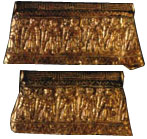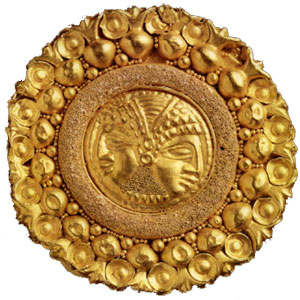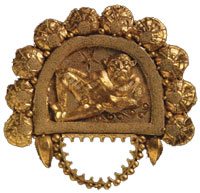|
|
The very antique technique of granulation has a past rich of traditions and of culture: in the oriental, ancient Egyptianand Mycenaean jeweller's of the second century b.C. attestations of this kind of work are infact found. But it is with the Etruscans that the granulation has its greatest splendour, in the so-called oriental period (seventh cen b.C.): the most important centre is "Vetulonia", where the manufacture reaches such a grade of refinement that the gold is reduced to small grains that look like dust. The technique of granulation consists in welding small spheres on top of a lamina, according to the design established in advance: gold is preferred for its great ductility and malleability, while silver is used less. Immense treasures have been found in the Etruscan tombs, rich of jewels and gold objects, that are made precious with refined decorums obtained with the granulation. In the Etruscan jewels the granules are often disposed in a way to form geometric and floral decorations: the greatest difficulty is represented exactly by the welding , because the small spheres risk, with the high heat, to lose their conformation. |
|
|
|
|
|
|
|
|
With the Roman colonization of the Etruria, both for the wars and for the change of fashion, the application of the granulation becomes more and more rare, untill at a certain time it disappears without bequeathing a precise knowledge of the formula that had allowed the realization. In the following centuries many people have tried to find out the secret of the granulation, starting from the Byzantine artisans to "Benevenuto Cellini, to famous "Castellani" goldsmiths,upto the latest researchers achieved by the most famous firms of the area. An ancient tradition continues in the jewelry of our days, renewing in the form and in the decorums, the splendours of a jewelry that from the past is projected in.
|
|




